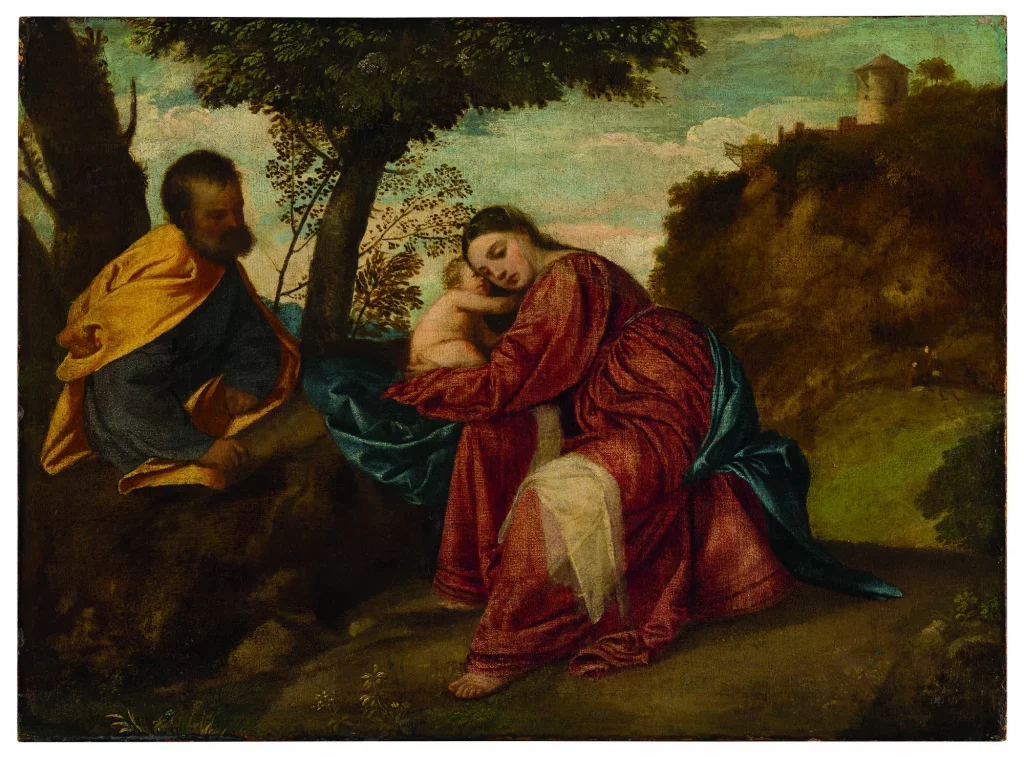Auctions
Stolen Titian, Once Found at a London Bus Stop, Sells for a Record $22 Million
The work had also been looted by Napoleon in the 19th century.

The work had also been looted by Napoleon in the 19th century.

Margaret Carrigan

A small Titian painting with a storied past has reset the auction record for the famed Renaissance artist. The Rest on the Flight into Egypt (ca. 1508-10) sold for £17.6 million ($22.1 million), including fees, at Christie’s Old Masters sale in London on July 2. The Biblical scene, measuring just 18 by 25 inches, has passed through the hands of emperors, aristocrats, and archdukes, and was stolen—twice.
The work bore a presale estimate of £15 million to £25 million and was backed by a third-party guarantee. It sold to a phone bidder, likely its guarantor. According to the auction house, its “intimate” size is typical of Titian’s earlier works.
The artist’s previous record of $16.9 million was set in the 2011 sale of A Sacra Conversazione: The Madonna and Child with Saints Luke and Catherine of Alexandria at Sotheby’s New York.
“This result is a tribute to the impeccable provenance and quiet beauty of this sublime early masterpiece by Titian, which is one of the most poetic products of the artist’s youth,” said Orlando Rock, the chairman of Christie’s U.K. “This picture has captured the imaginations of audiences for more than half a millennia and will no doubt continue to do so.”
The Rest on the Flight into Egypt was first recorded in the collection of a Venetian merchant in the early 17th century before it was sold to Sir James Hamilton of Holyroodhouse and then on to Archduke Leopold Wilhelm of Austria. The Archduke esteemed his collection so highly that, in the mid 1600s, he commissioned a kunstkammer series of paintings to capture all of his trophy artworks. The Rest on the Flight into Egypt appears in one these paintings, which is now in the Prado in Madrid. After a few generations bouncing between Holy Roman Emperors, the work was first stolen when it was looted by French troops in 1809 during Napoleon’s occupation of Vienna. (It was returned in 1815.)
Its second theft was far more recent. In 1995, it was stolen from England’s Longleat, the home of the descendants of John Alexander Thynne, 4th Marquess of Bath, who had acquired the work from the London dealer Colnaghi. The gallery for its part, had bought it in a Christie’s sale in 1878 for 350 guineas (around $46,700 today)—the most of any of the 11 works by Titian in the sale. After it was stolen, Thynne’s heirs called in an art detective, Charles Hill, to help find the painting, then valued at £5 million. It wasn’t until 2002, however, that the painting turned up, frameless and stuffed in a plastic bag, at a bus stop in London in exchange for a £100,000 reward.
It was returned to Longleat and has been there ever since, except for its appearance in the 2012 exhibition “Titian’s First Masterpiece: The Flight into Egypt” at the National Gallery, London.
After the sale, Lord Bath, who succeeded his father as the Marquess of Bath in 2020 and inherited the Longleat estate, said it was “fabulous” to see the interest in the painting.
“As the next chapter in the Rest on the Flight into Egypt’s story is written, I am pleased with the outcome [of the sale]; which will support our considerable long-term investment strategy at Longleat to build on the vision and legacy of my ancestors for the benefit of future generations,” he said.